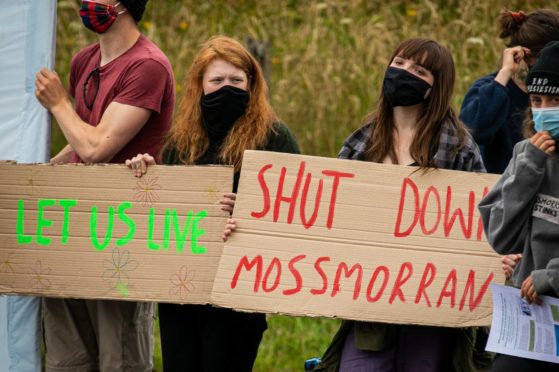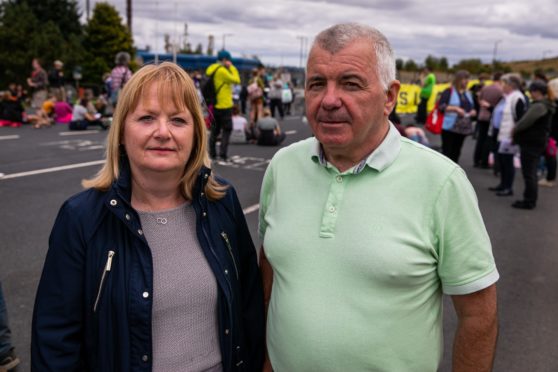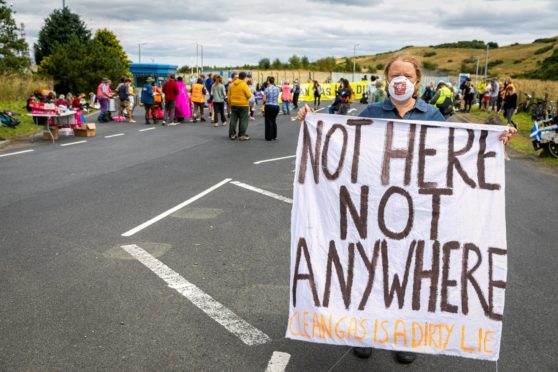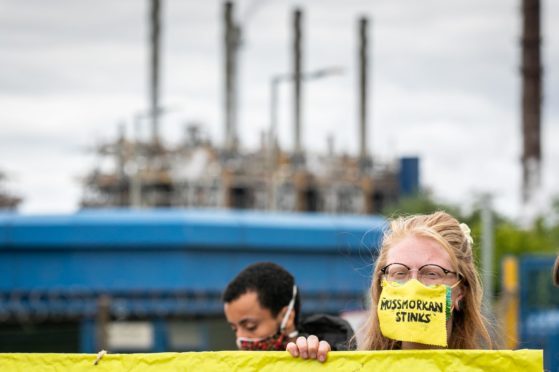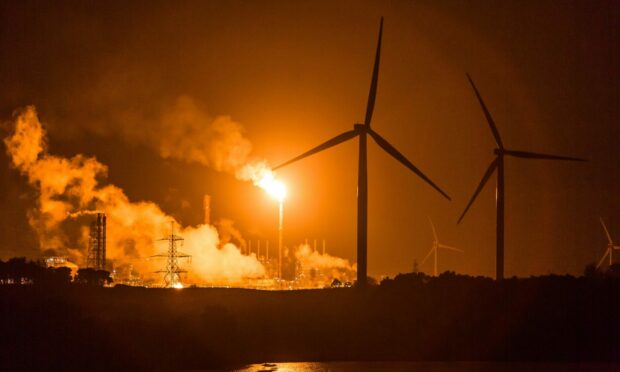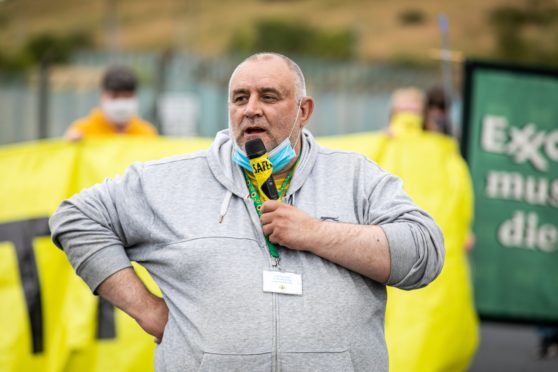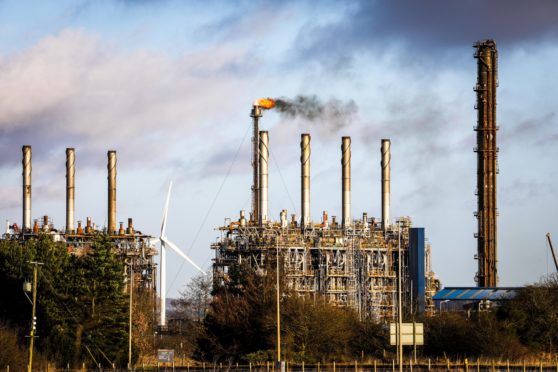Mossmorran activists are still campaigning for the petrochemical plant’s closure, despite a £140 million upgrade.
Sunday saw the biggest protest yet outside the Fife factory as Climate Camp Scotland’s weekend of action drew to a close.
The demonstration follows several bouts of horrendous flaring at the Cowdenbeath site, which impacted on neighbouring communities and could be seen from 120 miles away.
ExxonMobil is facing prosecution for two previous incidents but insists its multi-million-pound investment will make the plant more reliable and reduce the impact of flaring.
However, people are not convinced.
As the campaign continues, we spoke to:
- A local couple whose house vibrates every time the plant flares.
- Campaigners who don’t believe the investment will make much difference.
- Climate change activists who say the plant causes too much pollution.
- An anti-fracking campaigner who won his “David and Goliath” battle against Ineos on what Mossmorran protesters can do to win their fight.
- And ExxonMobil, which says the plant is integral to Scotland’s energy supply
‘Our house vibrates’
James and Sheila Somerville live in the shadow of the huge plant and have suffered its effects for years.
Their house vibrates every time it flares and night is turned into day with the light pollution.
Sheila said: “Ornaments vibrate on the shelves. It’s horrendous and it’s frightening.
“The light from it glows through the blinds and the whole bedroom is lit up at night.”
James added: “When it’s really bad we can hear it rumbling over the telly.
“One time we thought there was an Apache helicopter flying out the back, that’s how loud it was.”
Even when it’s not flaring, the couple can still hear the plant and they live in fear of further incidents.
“We just want it away, shut down, so we can live in peace,” said Sheila.
Investment ‘shouldn’t have happened’
Meanwhile, Jemma Kettlewell from campaign group Actions Speak Louder Than Words, is not reassured by the plant’s upgrade.
“I just don’t believe it will help,” she said.
“They were forced by Sepa to do it and £140m might cover up what’s coming out of there but there’s still CO2 and other pollutants.
“Exxon is Scotland’s third largest polluter and people who live near it are reporting asthma, respiratory problems, itchy eyes, stress and anxiety.”
Like many others, Jemma wants to see a move away from hydrocarbons and has called for a “just transition” towards green energy.
“The investment shouldn’t have happened,” she said.
Are we happy with the £140m investment? Not at all.”
Linda Holt, Mossmorran Action Group.
“The money should have been spent on retraining the workers for green, renewable jobs.
“The people who work there are concerned about their jobs so the workers and the community should be at the forefront of a just transition.”
And Jemma isn’t the only one to feel this way.
Linda Holt from the Mossmorran Action Group (MAG) said people had had enough.
MAG has been logging complaints from the public on an “impacts map” on its website and Linda said: “It’s really quite stunning to read.
“The impacts stretch from the south of Edinburgh to Perth and Kinross.”
The group also encourages people to report concerns to Sepa during flaring incidents.
“One event alone generated more than 1,400 complaints,” she said.
“The fact is Exxon has been running the plant into the ground for years.
“There were two separate boiler explosions that Sepa described as catastrophic and as a result, the plant was shut for seven months.
“Are we happy with the £140m investment? Not at all.
“We want a just transition but there are no plans for that.”
‘We won our David and Goliath battle’
Sunday’s protest also received support from other campaigners across Scotland, who expressed solidarity with locals.
Callum McLeod, from Edinburgh, formed a group against plans by Ineos to begin fracking in the Firth of Forth near its Grangemouth plant.
Our Forth Against Unconventional Gas was ultimately successful when the Scottish Government declared a moratorium against fracking in the firth.
Callum offered advice to the Mossmorran activists.
“In our case, there were lots of different groups all fighting for the same thing,” he said.
We started as David but now we’re Goliath.”
Callum McLeod.
“We were struggling until we all realised we would have more power working together.
“It was after that we started lobbying the Scottish Government.”
Callum reckons a grass roots campaign involving regular meetings, a petition and the power of social media is the way to go.
“Join up with others, grow, recognise there are differences but don’t fight each other,” he said.
“Recognise there are some dark times but just keep on powering through the storm until the sun comes up.”
He added: “It’s like David and Goliath. We started as David but now we’re Goliath.”
Mossmorran ‘integral to Scotland’s energy supply’
Despite the protests, ExxonMobil believes its investment will make the plant much quieter and less visible.
The work includes a new noise-reducing flare tip, and a 14-step flaring reduction plan to reduce the impact on communities.
A new ground flare will be installed next year and this should significantly reduce elevated flaring – the main source of noise pollution.
Exxon operates Fife Ethylene Plant and shares the Mossmorran site with Shell’s NGL facility.
A spokesman agreed climate change action is needed but added: “It’s going to take all of us – business, governments and consumers – to make meaningful progress.
“Our focus includes reducing our emissions, helping consumers reduce their emissions, and developing lower-emission energy solutions.”
The company said 30 years of independent analysis from Sepa and Fife Council had concluded there were no local air quality issues associated with Mossmorran.
‘’We are committed to making our operations much quieter and less visible through significant investment at FEP,” the spokesman said.
“This includes a recently-completed £140m plant upgrade, a 14-step flaring reduction plan and an investment in an enclosed ground flare, which alone will reduce elevated flaring by at least 98% when it becomes operational next year.
‘’The Mossmorran facility is integral to Scotland’s energy supply, meeting the needs of communities nationwide.
“Furthermore, FEP directly supports the manufacturing supply chain for important products such as medical supplies, electric vehicle parts and food packaging.’’
Sepa monitoring
Sepa has pledged to continue monitoring the site, even once the work is complete.
Chief executive Terry A’Hearn said: “Communities across Fife have the right to a future where flaring is the exception rather than routine.
“Robust regulation takes time, but through our work and the significant investment by site operators, a clear pathway to compliance is now in sight.
“Local communities can be assured of our continued vigilance over this important period and beyond.”
Sepa issues regular updates on its website and has also promised to make monitoring results more visible.
